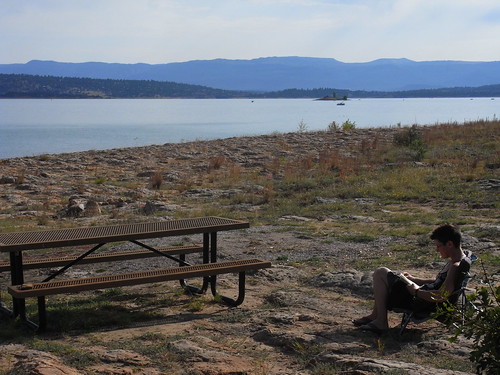We’ve looked down from the main dam at Heron Lake before, but the fresh perspective from the Rio Chama trailhead brings us face to face with our erroneous mental map of this place. We had pictured Heron Lake and the nearby El Vado (The Ford) Lake as two back-to-back reservoirs on the Chama River. But now we are looking down into the Chama River valley from below Heron Lake, and just above the dam spillway that simply adds to the river. We realize we crossed the Chama on our way in, a scrawny New Mexico river at best in August, and it clearly flows right past Heron Lake. So where does the water we’ve been swimming in come from?
We try out one of the camping areas closer to the road this time, Piedra (Rock) Cove. Balloons at the entry announce the wedding of Juan y Mari, and the ceremony is underway when we arrive. The bride and groom are standing by the water, all in white. Thankfully no one takes notice of our noisy rig coming in and getting settled. When we look back the bride and groom are in the water, splashing the rest of the wedding party. One, the best man perhaps, is held face down in the water by the groom until we start to wonder if we are witnessing a dark side of their ritual. But soon everyone is laughing again. They turn out to be good neighbors for the weekend, always having fun swimming, singing, yelling back and forth in English and Spanish, or throwing water baloons, but never being especially noisy. No generators or stereos at this wedding.
On Sunday I hike the Rio Chama trail to El Vado, and verify that it is indeed on the Chama River. It’s not a “no wake” lake like Heron, and buzzes with motorboats. I get a few angles on the Heron spillway, which seems to double the volume of the Chama and change the color of the water from a clear dark green to cloudy turquoise.
It turns out that Heron Lake it not what it seems. Wikipedia reveals that lake’s namesake is not a bird, but the water engineer Kenneth Heron whose vision to divert water under the continental divide to northern New Mexico was realized with the construction of several diversion tunnels from the upper San Juan river in the 1960’s, including the 12.8-mile Azotea Tunnel that feeds Heron Lake. The tunnel took six and a half years to build. Most of the water goes to the thirsty city of Albuquerque.
